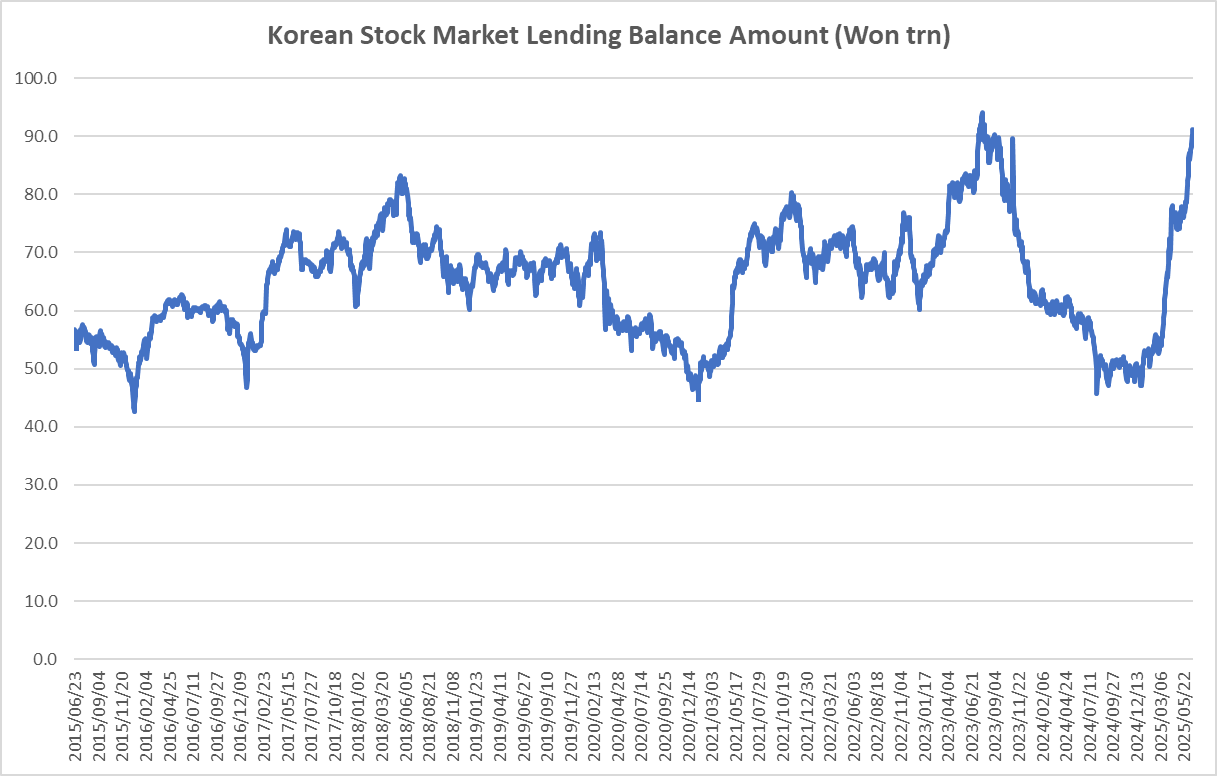A Sharp Increase in the Lending Balance of Korean Stock Market Suggests A Pull-Back
In our view, the sharp increase in the lending balance is one of the signs of many investors preparing for a pull-back in the Korean stock market.
The lending balance of the Korean stock market surged from 47.3 trillion won on 2 January 2025 to 90.4 trillion won as of 20 June 2025.
The rising lending balance in the Korean stock market could be construed as a bearish sign.
There has been a sharp increase in the lending balance of the Korean stock market. It is estimated that more than 70% of the lending balance transactions are usually related to short selling in Korea so the increase in the balance can be interpreted as a bearish sentiment on the market as there are more investors that expect a decline in stock prices.
The lending balance refers to the amount of stocks borrowed by foreign or domestic institutions for the main purpose of short selling and not yet repaid. In order to liquidate the balance, investors must repay with the amount they have, or if they sold, they must repurchase the same amount as the amount sold.
The lending balance has risen to the highest level in about two years in the Korean stock market to 90.4 trillion won ($65 billion) (KOSPI and KOSDAQ combined) as of 20 June 2025. The last time that the lending balance exceeded 90 trillion won was on 3 August 2023.
Our Thoughts on the Sharp Increase in the Lending Balance - In our view, the sharp increase in the lending balance is one of the signs of many investors preparing for a pull-back in the Korean stock market which has been one of the best performing among the OECD countries. KOSPI is up 25.7% YTD, outperforming S&P 500 (up 2% YTD), Nikkei (down 2.4%), and Hang Seng (up 20.7% YTD).
Many investors (especially local) are front-running, betting that the new Presidential administration could make real changes to improve corporate governance. Among the proposed changes, the three most important ones include cancellation of treasury shares, lower dividend taxes, and better protection of minority shareholders in the event of corporate spin-offs.
Nonetheless, it remains uncertain how quickly the new administration will be able to make the changes into law. As there are likely to be ongoing hiccups and roadblocks to these and other major changes, some investors are likely to become disappointed.
Many investors are concerned about the reality of exactly what changes could actually happen. This skepticism is one of the key reasons for the rising lending balance in the Korean stock market and this could be construed as a bearish sign.
Korean Stock Market Lending Balance Amount
The chart below shows the lending balance amount of the Korean stock market in the past decade which has ranged from 43 trillion won (low in December 2015) and 92 trillion won (high in July 2023).
The lending balance of the Korean stock market surged from 47.3 trillion won on 2 January 2025 to 77 trillion won at end of May 2025 and 90.4 trillion won as of 20 June 2025.
The sharp increase in the lending balance can be attributed to the end of the ban on short selling Korean stocks as of 31 March 2025 combined with the recent, strong rally in the Korean stock market, especially in the past two months.
The sharp increase in the lending balance amount from the end of 2024 to 23 June 2025 has been unprecedented in the past 10 years. At current pace, it appears that the lending balance amount could well surpass the previous peak levels in July 2023.
Source: https://freesis.kofia.or.kr/
Keep reading with a 7-day free trial
Subscribe to Douglas Research Insights to keep reading this post and get 7 days of free access to the full post archives.


